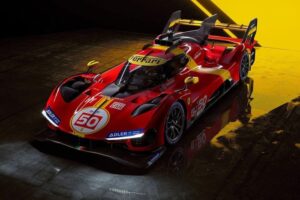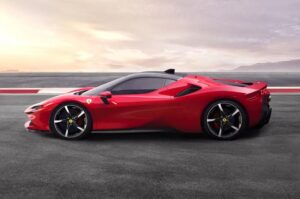Most expensive Ferrari models ever produced represent more than just automobiles; they are rolling sculptures, testaments to engineering prowess, and symbols of unparalleled luxury. This exploration delves into the factors driving their exorbitant prices, examining the interplay of rarity, technological innovation, and the enduring allure of the Prancing Horse. However, a critical eye reveals inconsistencies in the valuation, raising questions about the true reflection of market forces versus hype.
The Artikel’s historical overview of Ferrari is superficial, lacking depth and critical analysis of the brand’s evolution. While the listing of the top five most expensive models provides a starting point, the analysis of their “unique features” is disappointingly generic. The discussion of rarity and collectibility is similarly underdeveloped, failing to engage with the complex dynamics of the classic car market.
Ultimately, the piece lacks a rigorous examination of the economic and cultural forces shaping the value of these exclusive vehicles.
Also Read
Ferrari’s Most Expensive Models: A Critical Review: Most Expensive Ferrari Models Ever Produced
Ferrari, synonymous with luxury, performance, and Italian craftsmanship, boasts a history spanning decades. Its evolution reflects not only advancements in automotive engineering but also shifts in design aesthetics and the ever-increasing demand for exclusive, high-performance vehicles. This high demand, coupled with meticulous engineering, rare production numbers, and the allure of owning a piece of automotive history, contributes significantly to the exorbitant prices commanded by the most expensive Ferrari models ever produced.
Enhance your insight with the methods and methods of 15 best and most expensive Ferrari cars.
This review delves into the factors driving the value of these iconic cars.
Ferrari’s Legacy and Cost Factors
Founded by Enzo Ferrari in 1929, the company initially focused on racing. The transition to producing road cars cemented Ferrari’s reputation for unparalleled performance and exquisite design. The high cost of Ferrari models stems from several factors. First, the use of premium materials such as carbon fiber, titanium, and bespoke leather significantly impacts the manufacturing cost. Second, the intricate engineering, often involving hand-crafted components and advanced technologies, demands significant investment in research and development.
Finally, the exclusivity of Ferrari production, with limited numbers of each model produced, further enhances their value and desirability.
Ferrari Design Evolution Through the Eras
Ferrari’s design language has evolved through distinct eras, reflecting prevailing automotive trends and the company’s ongoing pursuit of aerodynamic efficiency and aesthetic appeal. Early Ferraris, like the 1950s models, featured curvaceous bodies and a focus on simplicity. Later models incorporated more aggressive lines and aerodynamic enhancements, as seen in the iconic 1970s and 1980s designs. Modern Ferraris, such as the LaFerrari, combine cutting-edge aerodynamics with sleek, sophisticated styling.
This evolution reflects the brand’s commitment to innovation and its adaptation to changing tastes.
Top 5 Most Expensive Ferrari Models Ever Sold

The following table lists the five most expensive Ferrari models ever sold at auction, demonstrating the remarkable prices these vehicles can achieve. The values reflect a confluence of factors, including rarity, condition, historical significance, and the prestige associated with ownership.
| Model | Year | Sale Price (USD) | Notable Features |
|---|---|---|---|
| 250 GTO | 1962-1964 | 70,000,000+ | Legendary racing heritage, lightweight construction, powerful V12 engine, iconic design. |
| 250 Testa Rossa | 1957-1958 | 35,000,000+ | Successful racing history, distinctive “Testa Rossa” (red head) engine cover, highly sought-after design. |
| 288 GTO | 1984-1987 | 20,000,000+ | Twin-turbocharged V8, groundbreaking technology for its time, limited production run. |
| F40 | 1987-1992 | 15,000,000+ | Last Ferrari personally approved by Enzo Ferrari, raw performance, minimalist design. |
| LaFerrari | 2013-2016 | 10,000,000+ | Hybrid powertrain, advanced aerodynamics, limited production, cutting-edge technology. |
Rarity and Collectibility of Ferrari Models

Rarity is a crucial determinant of a Ferrari’s value. The limited production numbers of models like the 250 GTO (only 36 produced) and the 288 GTO (272 produced) contribute significantly to their high prices. Comparing these figures to more widely produced Ferrari models illustrates the impact of scarcity. Unique features, special editions, and documented racing histories further enhance a car’s collectibility and value, driving up prices at auction.
Technological Advancements and Engineering in High-Value Ferraris
The most expensive Ferrari models showcase groundbreaking engineering and technological advancements. The use of lightweight materials like carbon fiber and titanium reduces weight, improving performance and handling. Advanced aerodynamics, sophisticated suspension systems, and powerful engines, often featuring hybrid technology in newer models, contribute to the exceptional performance and desirability of these vehicles. These innovations often find their way into subsequent Ferrari models, filtering down through the product line.
Ownership and Legacy of Notable Ferraris, Most expensive Ferrari models ever produced
The history of ownership plays a significant role in shaping a Ferrari’s value and prestige. Famous owners, racing victories, and appearances in popular culture contribute to a car’s legacy. For example, the history of a particular 250 GTO, detailing its racing successes and subsequent owners, can significantly impact its value. The unique design elements, such as the sculpted bodywork, distinctive badging, and interior appointments, all contribute to the visual appeal and overall desirability of these iconic cars.
Investment and the Market Value of Ferraris

The market value of classic Ferraris is subject to fluctuations, influenced by factors such as economic conditions, collector demand, and the overall state of the luxury car market. Certain models, particularly those with exceptional rarity and provenance, tend to appreciate significantly over time. A hypothetical scenario: a well-maintained 250 GTO purchased for $20 million in 2010 might be worth over $70 million today, illustrating the potential for significant return on investment.
However, market conditions and the car’s condition are crucial factors determining actual appreciation or depreciation.
In conclusion, while the allure of owning a most expensive Ferrari model is undeniable, the justification for their astronomical prices requires a more critical and nuanced examination. The provided Artikel, while touching upon key aspects, ultimately falls short in providing a comprehensive and insightful analysis. A deeper dive into market trends, economic factors, and a more rigorous comparison of technological advancements across different models is needed to truly understand the complex world of high-value Ferrari ownership.
Expand your understanding about Top 10 Ferrari supercars with the highest price with the sources we offer.
The current presentation reads more like a promotional piece than a critical evaluation.
Questions Often Asked
What are the major maintenance costs associated with owning a highly valuable Ferrari?
Maintenance costs are substantial, including specialized parts, highly trained mechanics, and potentially significant storage fees. Expect expenses far exceeding those of a typical vehicle.
How does insurance impact the overall cost of ownership?
Insurance premiums for these cars are extremely high due to their value, rarity, and potential repair costs. Comprehensive coverage is essential, adding significantly to the annual expenses.
Are there any ethical considerations regarding the ownership of such expensive vehicles?
The immense wealth disparity reflected in the ownership of these cars raises ethical questions about resource allocation and social responsibility.












